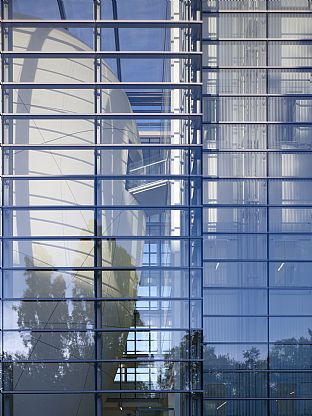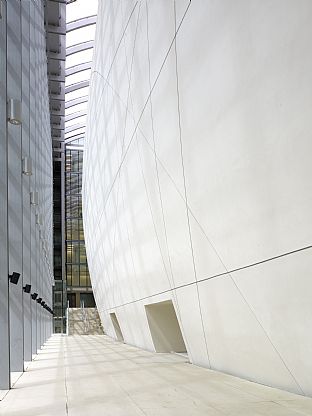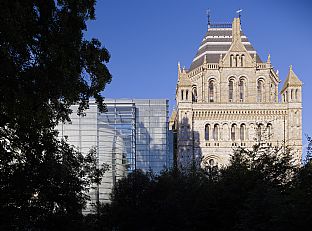14.9.2009
Grand Opening of the Darwin Centre
Monday 14 September marks the grand opening of the new Darwin Centre at the Natural History Museum in London, with the participation of Prince William and Sir David Attenborough. From Tuesday 15 September, the centre will be open for the public.
The Natural History Museum is both one of the UK's top five visitor attractions, and a world-leading science research centre. The architecture of both phases of the Darwin Centre are designed to reflect this dual role, and, through innovative and ambitious design, reveal to the public for the first time the incredible range and diversity of the Museum's collections and the cutting-edge scientific research they support.
Neil Greenwood, the Natural History Museum's Programme Director for the Darwin Centre, explains, 'Many people love the Natural History Museum for its iconic Victorian Waterhouse building. However, through the Darwin Centre, we wanted to challenge this traditional perception and highlight the work of our scientists and the importance of our collections. The Darwin Centre is set to be a truly inspirational addition to the Natural History Museum when it opens to the public on 15 September 2009.'
The second phase of the Darwin Centre, designed by C F Møller Architects, completes the western site of the Natural History Museum, uniting Alfred Waterhouse's terracotta construction from 1881, with the first phase of the Darwin Centre which opened in 2002. Like the rest of the Natural History Museum, the new completed Darwin Centre plays three important roles: safeguarding the millions of specimens in the Museum's collections, providing research facilities for our scientists, and inspirational public spaces for visitors engaging them in a dialogue with science in a new and innovative way. It is these three uses that are central to the design of both phases of the Darwin Centre.
Darwin Centre: Second Phase
Designed by C F Møller Architects, the second phase of the Darwin Centre takes the form of a huge eight-storey concrete cocoon, surrounded by a glass atrium. This centerpiece is made to appear like a large silk cocoon, and forms the inner protective element of the Darwin Centre's second phase. The scale of the Cocoon is such that it cannot be seen in its entirety from any one position, emphasizing its massive scale. The shape and size give the visitor a tangible understanding of the volume of the collections contained within.
The collections areas within the Cocoon are world class, the regulation of temperature and humidity, as well as the separation of work and storage areas reduce the risk of pest infestations ensuring that the collections will be protected and preserved for many years to come.
Public access to the scientific core of the second phase of the Darwin Centre takes the form of a visitor route up and through the cocoon, overlooking the science and collection areas. This provides a complimentary activity to the Darwin Centre's other function of protection, preservation and research. The visitor can experience the Darwin Centre as a compelling and interactive learning space, observing the scientific and research activities without interrupting scientific work in progress.
Anna Maria Indrio, partner at C. F.Møller, comments "C. F. Møller Architects is very proud and honoured to have been given the task of designing a framework for the Natural History Museum's unique collection of plants and insects. The large silk cocoon protected by a glass atrium encloses a fantastic treasure, reflecting evolution itself. The macroscale of the space and the size of the cocoon expresses the enormous importance of the collections. Iconic forms should only be used if the relationship between the building and its interpretation is entirely self-evident, as it is in this case.
The new building has completely changed the Natural History Museum's relationship with the site from being an introvert to an extrovert building. It was incredibly demanding to solve the task of the second phase of the Darwin Centre in this way, but the cocoon will become a major attraction and a trademark of the Darwin Centre in the future."
The second phase of the Darwin Centre in numbers
the second phase of the Darwin Centre has cost £78 million
the base construction took around 25 months and 280 people to build
at 60 metres long, 12 metres wide, 300 millimetres wall thickness and 3,500 square metres, the eight-storey-high cocoon is the largest sprayed concrete, curved structure in Europe
the cocoon will hold 17 million entomology specimens and three million botany specimens in 3.3 kilometres of cabinets
these cabinets would stretch from the Natural History Museum in South Kensington to Westminster Cathedral if put end to end
the cocoon will be kept at a steady 17°C and 45 per cent relative humidity, the optimum conditions to store collections
the second phase of the Darwin Centre has 16,000 square metres of floor space
the building will accommodate up to 220 staff and science visitors
there will be 1,040 square meters of laboratory space, doubling the size of the Natural History Museum's current laboratory areas
2,500 people per day will be able to take a self-guided journey through the collections
and research areas
C. F. Møller Architects was chosen for the commission in 2001, in competition with 59 other international architectural firms.
For more information please contact:
Architect Anna Maria Indrio, partner at C. F. Møller Architects, telephone +45 3288 7844







